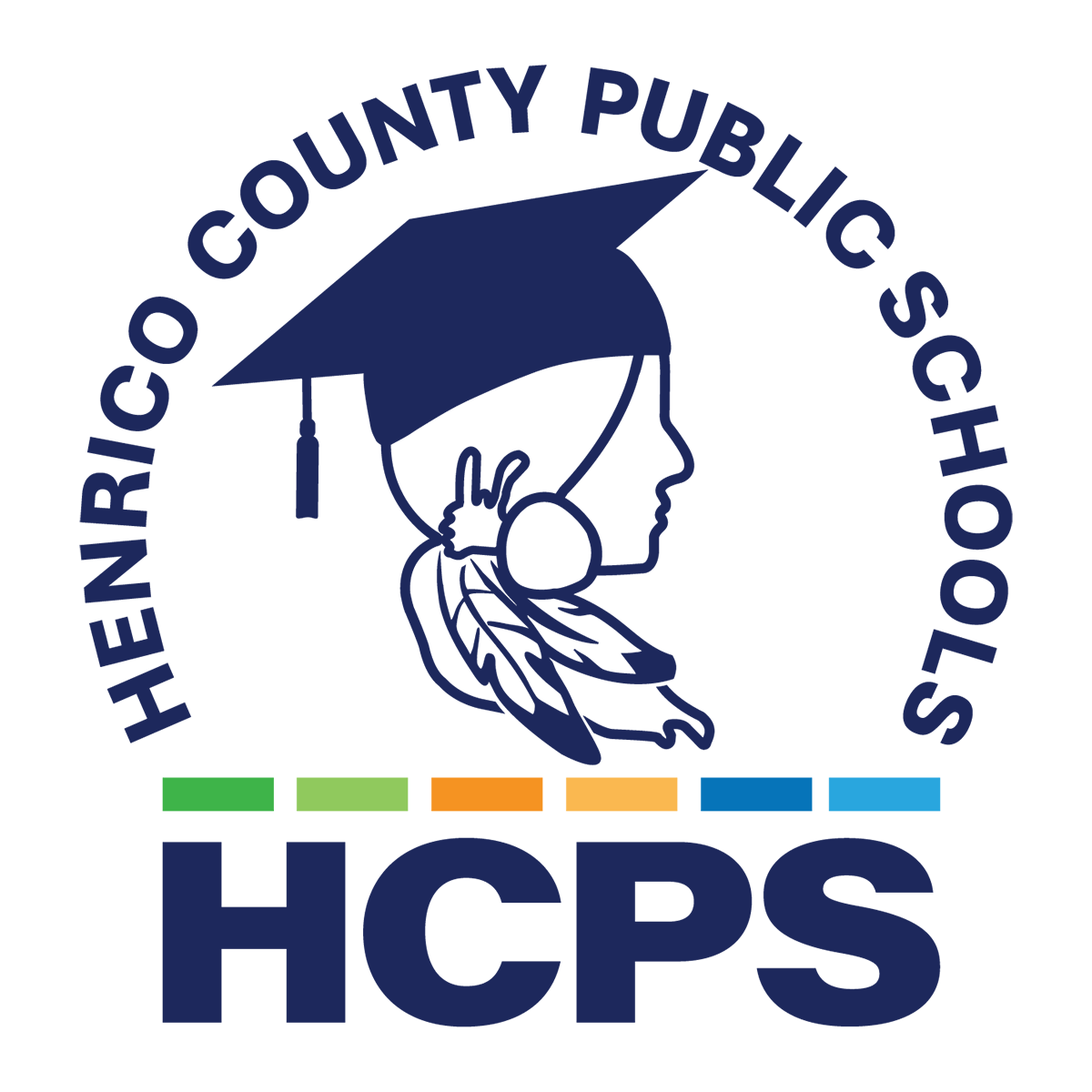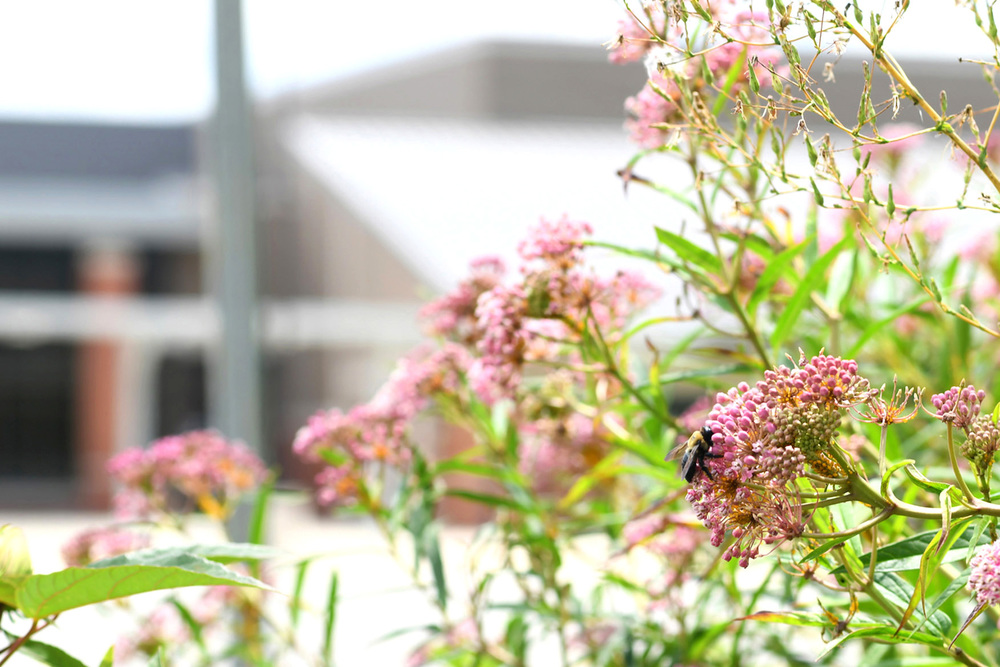Maybe it was Jeff Grow’s last name that started it all. For years, the maintenance control supervisor in Henrico County Public Schools’ Facilities Department has nurtured a seed of an idea: he envisions swaths of native wildflowers teeming with butterflies, bees and other pollinators thriving in underused areas of HCPS campuses. In April 2024, Grow’s department and the Virginia Department of Wildlife Resources launched a pilot project at J.R. Tucker High School based on the concept. As the idea takes root, it stands to benefit students, the community and the environment, while making his department’s work safer and more efficient.
One of Grow’s responsibilities is helping coordinate the crews that mow the sprawling lawns of HCPS schools, program centers and offices. That includes areas with steep slopes that can be difficult or even dangerous to mow.
“I thought, you know, how could we take those pieces of property and convert them to something that we don't have to mow?” Grow said. “I drive down Route 288 every day on my commute and I see the big signs that say ‘Wildflowers — Do not mow.’ And I went, wow, couldn't we do that instead of what we're doing? And that's kind of where it started.”
In the spring of 2022, Grow made a few calls about the idea without much success. A fishing buddy who works for the Virginia Department of Game and Inland Fisheries suggested he contact Stephen Living, habitat education coordinator with the Virginia Department of Wildlife Resources. Living shared Grow’s enthusiasm and signed on to the project, creating a plan and providing expertise.
A few weeks later, they found a possible pilot site: an unassuming hill behind the nearly completed J.R. Tucker High School. Part of the hill became waterlogged when it rained, and stabilizing it was the last item needed for the new school to secure final construction approval from Henrico County inspectors.
“We kept battling it and looking at things we could do to stabilize it,” said Susan Moore, HCPS director of facilities. “And then mother nature took over. We noticed plants were just coming up on the hill naturally.”
Moore, Grow and Nicole Olivencia, the department’s senior capital projects manager, discussed the concept of a pollinator garden and Olivencia presented it to Henrico County inspectors. They liked the idea.
The Virginia Department of Wildlife Resources got things started by installing nearly 2,000 plugs of wetland plants which thrived on the moist hill.
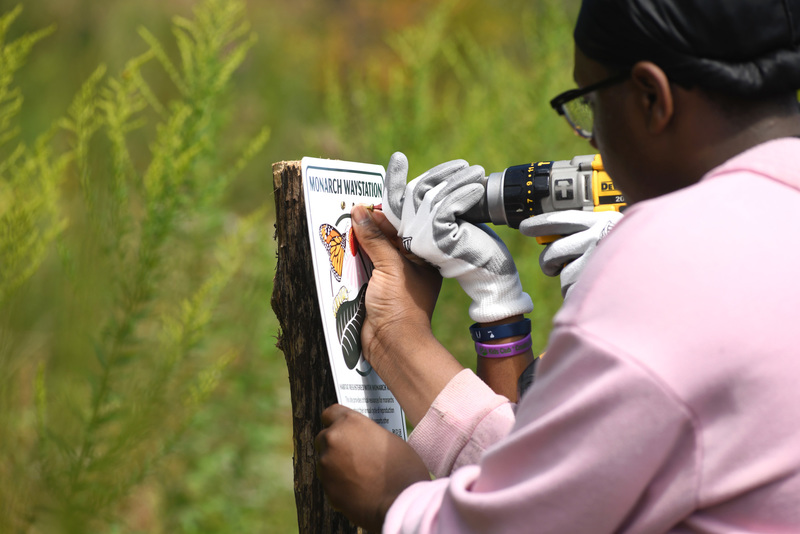
Student involvement and instruction
As a student in Chesterfield County, Grow enjoyed his career and technical education classes. He has worked to involve a wide variety of HCPS students in the creation and maintenance of the J.R. Tucker garden. It’s a template he wants to use for similar projects.
“We got kids in our horticulture programs to come out and participate in preparing the area, planting seeds and putting the erosion control measures down to protect the environment and the storm drains,” Grow said.“ Then the students began to grow some of the plants in the greenhouse during the winter to transplant to this plot.”
HCPS carpentry students built a large pollinator habitat sign using construction plans created by students in the division’s computer-assisted design program. The sign was printed by HCPS graphic communications students. More in-depth interpretive signs are planned.
Natural gardens change their appearance with the seasons and like nature, do not always appear tidy. Because school visitors may be used to seeing manicured lawns, the sign provides context.
“We're an educational organization and part of what we need to do is to educate the public and even our leadership,” Grow said. “If they walk by and say, ‘Hey, this looks a little unkempt,’ the signs will convey that we're being good stewards of the environment. It’s not only what we do inside our schools, like recycling.”
Living, the state habitat education coordinator, said that students and community members will be involved in the ongoing maintenance, which should be minimal given the garden’s naturalized approach — perhaps an annual cutting back.
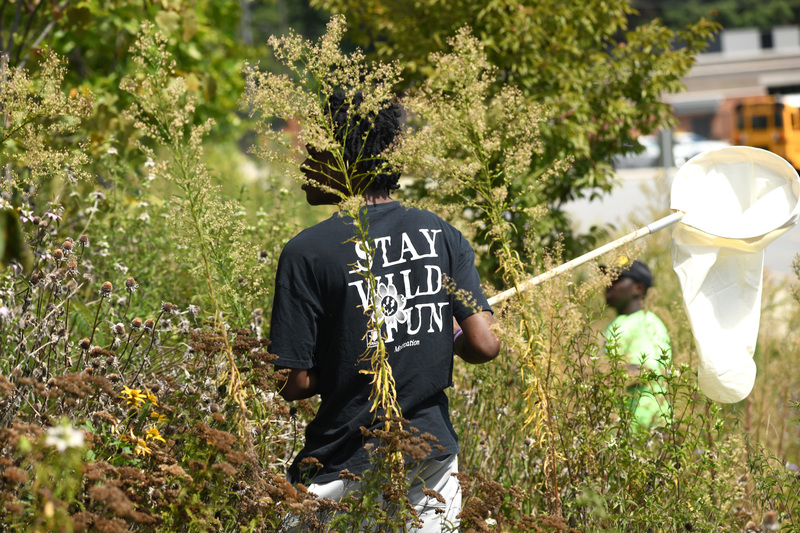
Outdoor classroom
As an instructional resource, the garden “can obviously be used for STEM exploration,” Living said, “but also visual arts and journaling and other avenues the gardens can be used for. It’s building on the traditional view of these gardens as a teacher-driven instructional space, to one that’s collaborative across all aspects of a school.”
Heather Veneziano, horticulture teacher at the Advanced Career Education Center at Virginia Randolph, accompanied a group of students to the garden on a sunny day in early September, where they helped install a new “Monarch Waystation” sign, then carefully netted pollinators on the hillside. Living pointed out a monarch caterpillar and butterflies and explained the importance of wildlife habitats for pollinators and other wildlife. As if on cue, a rabbit nosed through the dense plant life, bringing exclamations from the students.
“Animals need cover, not just food,” Living said. “That rabbit would not be here if this were a mowed grass hill. I saw a hawk out here hunting the other day, too. Now we have a habitat.”
Veneziano said the garden can serve a variety of purposes for science and horticulture students.
“We do this, one, so students can give back to their communities. Secondly, for horticulture students, it helps them think outside the box: to realize that sometimes a landscape design is created to help a homeowner or business fix a problem, not just for beauty. The third is so they can realize that gardens can help the environment. We’re not just planting something because it’s beautiful to us, it’s beneficial to the environment and the ecosystem. They’re learning how to reinvigorate dead zones where pollinators and wildlife just will not live.”
Similar spaces “will help students with their critical thinking and to understand possible avenues for jobs — thinking about jobs as an ecologist or a wildlife biologist, and how to get there.”
Monica Lewis, a visual arts teacher at J.R. Tucker, has started taking her classes to the garden.
“The cornerstone of my art teaching is observational drawing. The kids want to get better at drawing, and the way you get better at drawing is you get better at observing … At first, some of the kids will say, ‘Yeah, I can draw a flower’ and they just draw a flower like they drew one as a kid. And I say, ‘No, draw this specific flower — look at the specific edge of the petals. Look at this particular leaf.’”
“The fact that we can do this [at J.R. Tucker] in the fall, when we've got blooms, and then we can come back and do it in the winter time when the flower heads have become dried seed heads, and then we can hopefully do it again in the spring when some new buds are coming. You know, we can go through that whole life cycle, because it does take time to keep practicing these skills.
“Just walking out there for five minutes, I feel calmer. I notice the bees and the little creatures buzzing around, whereas when you look right over next to it, where we've got the lawn — there are no bees. There are no pollinators. There are no butterflies. So seeing that natural rhythm of the creatures and the plants that are blooming or drying out there, it's just a very interesting space to be in.”
HCPS employees are also learning new skills in the space. Grow has started using the garden to teach new HCPS Facilities employees how to care for similar sites while minimizing the use of herbicides.
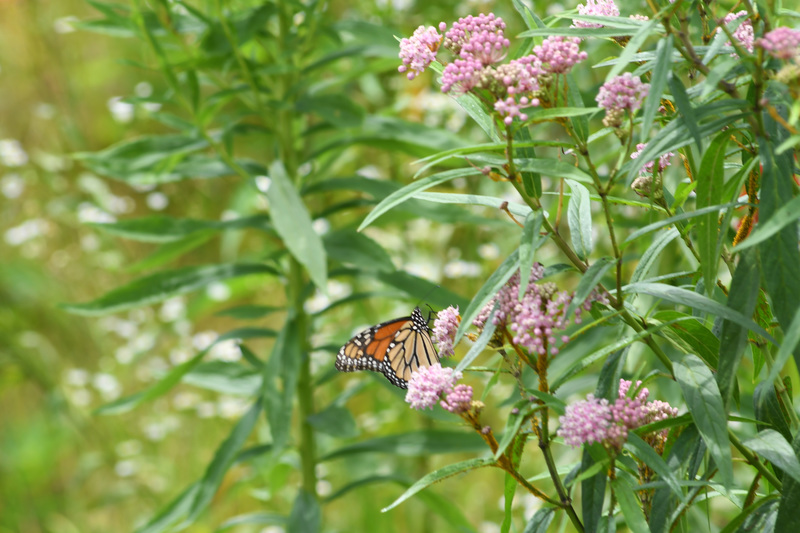
Cost savings and environmental benefits
“Localities have a pretty large public land base,” Living said. “It takes a lot of staff time to mow regularly. The ‘zero-turn’ mowers [used in large lawn-care operations] are expensive pieces of equipment. If school divisions could reduce their need for that equipment by just one or two mowers, that’s a significant cost savings.” Habitat gardens require “less fertilizer, less chemicals, less fuel being used. There is an environmental benefit there, including improved stormwater treatment. These areas do a great job at filtering pollutants out of the stormwater.”
When visitors pass the garden, they’ll see mostly plants native to Virginia.
“In projects like this where we’re improving habitat for wildlife, we look for plants that are native to the area,” Living said. “Wildlife is keyed in to taking advantage of the resources those plants offer, be it fruit, nectar, leaves to browse on — native plants are just far superior to non-native plants in supporting biodiversity. For instance, take songbirds and pollinators, which are very visible to people. Native insects eat native plants, and native insects are what birds eat. It takes more than 6,000 insects to feed a single nest of chickadees. Non-native plants don’t support that biodiversity. We have several hundred native milkweed plants at Tucker, too. Without milkweed, monarch butterflies can’t develop.”
The garden’s plants will be resistant to drought and won’t require pesticides and fertilizer, reducing runoff pollution in local creeks and rivers.
“If you choose a native plant that’s adapted for a specific site and conditions, it will far outperform a non-native species there. They’re just hardy. They’ve evolved to deal with those conditions. Part of the Tucker site is dry, and we picked plants that can deal with dry conditions. Once established, they won’t need supplemental watering. They don’t need fertilizer. In fact, we recommend that you not fertilize native plants, because fertilizing favors the weeds. Part of that slope is wet most of the time — we planted wetland plants and they’re doing well.”
Branching out
Will more pollinator gardens be popping up at schools across Henrico?
“We’re keeping our eyes open for possible sites,” Moore, the HCPS facilities director, said. “We’re trying to take it slow and do it right. Tucker presented itself as a unique first opportunity and it’s our test bed, as far as what we plant, how we need to maintain it, how well it does. And of course it will change from site to site depending on sun and shade and other variables.”
Grow sees a future where small plots produce big results.
“We have 76 school properties in Henrico County,” he said. “And if we could take a tenth of an acre, an eighth of an acre, a quarter of an acre at every single property and convert it into a pollinator garden or a natural habitat — things that are positive for the environment — we're no longer mowing unusable areas for no reason. We're not using gas. We're not using mowers and equipment and manpower. We’re not producing emissions. We can turn it into something that is environmentally beneficial. So little by little, we could eventually convert acres from useless mowing to these areas that are positive not just to the pollinators, but to our students, our staff and our community.”
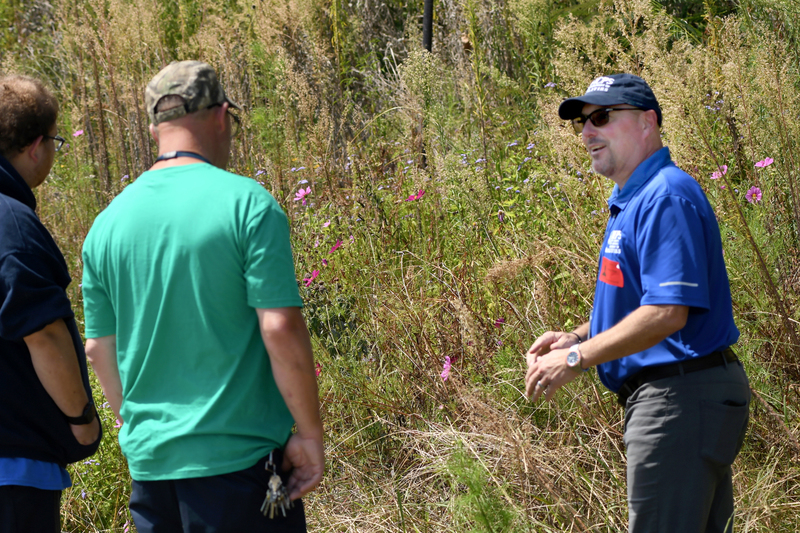
Jeff Grow, maintenance control supervisor with Henrico County Public Schools’ Facilities Department, talks with new HCPS employees. Landscaping crew members learn about the pollinator habitat as part of their training.
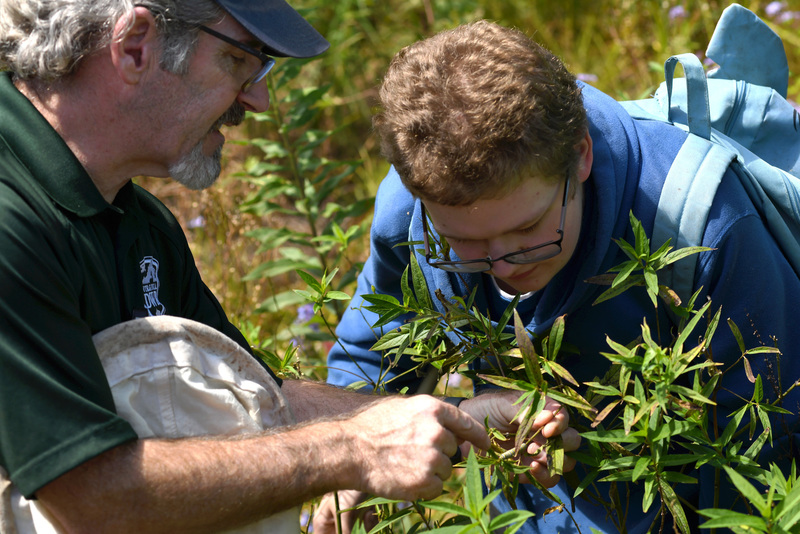
Stephen Living of the Virginia Department of Wildlife Resources shows a student a monarch butterfly caterpillar on a milkweed plant.
